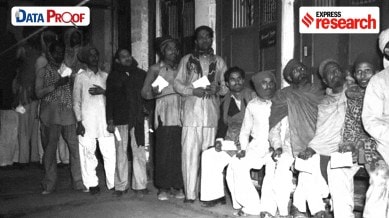From 1951-2019: How India voted in Lok Sabha elections
Since 1951, India has held 17 Lok Sabha elections, mobilising hundreds of millions of voters each time. Voter turnout has steady increased over the years, peaking in 2019 at over 67 per cent - a marked rise from the 44 per cent voter turnout in 1951.

There is a powerful role that numbers can play in narrating the life of a democracy. As India votes in the 18th Lok Sabha elections, we dig out some key numbers that have shaped the country’s electoral politics over the decades. Data Proof, a seven-part series, will tell the story of elections in India through numbers.
India is the world’s largest democracy, with over 96.8 crore people eligible to vote in the 2024 Lok Sabha election. To put that into perspective, India’s electorate is nearly four times larger than that of the United States, nearly 20 times larger than that of the United Kingdom, and seven times larger than that of Pakistan.
In the 2019 Lok Sabha polls, around 91.2 crore people were eligible to vote — over a six-fold jump in voters since 1951. After its first decade of independence until 2014, India’s voter turnout fluctuated between 55 and 62 per cent. Multiple factors affect voter turnout. These include the performance of the ruling party and candidates, the state of the Opposition parties, religion, caste, community, and ideology.
While the size of the electorate has increased considerably from the 1951 election till date, the voter turnout has seen a mixed trend.
The elections held in 1951 and 1957 saw a turnout of 44.87 per cent and 45.44 per cent respectively — the lowest for any decade. One of the reasons behind this was the logistics challenge in a country as young and as large as India.
India’s first election
The Election Commission of India (ECI) was established on 25 January 1950, with Sukumar Sen, an Indian Civil Service (ICS) officer, being appointed as the Chief Election Commissioner in March. On April 19 that year, while proposing The Representation of the People Act, India’s election law, Prime Minister Jawaharlal Nehru told Parliament that polls would be held in the spring of 1951. This posed a significant challenge for Sen, who was tasked with registering 17.5 crore eligible voters, more than 80 per cent of whom were illiterate.
Sen managed to register 17.3 crore voters. This number could have been higher but around 28 lakh women could not vote because they wished to register themselves as someone’s mother or wife (and not by their own names). Nonetheless, Sen admirably executed the task by embarking on a door-to-door campaign. The highest voter turnout was recorded in the Kottayam parliamentary constituency in Kerala (80.5 per cent) and the lowest in Shahdol in present-day Madhya Pradesh (18 per cent).
Highest and lowest turnout
The 2014 and 2019 elections witnessed a sharp rise in voter turnout —66.4 per cent and 67.4 per cent respectively. In the previous elections, the highest voter turnout was registered in 1984 and the lowest in 1971.
Even as the 1971 Lok Sabha elections saw Indira Gandhi’s Congress (R), with a few allies, winning 352 Lok Sabha seats, there was a harp decline in the voting percentage. The reasons for low turnout can be attributed to the split in the Congress Party in 1969, and Indira Gandhi’s decision to dissolve the Lok Sabha before the end of its five-year term and order general elections one year ahead of its schedule. However, her decision to impose Emergency led to her party’s stunning defeat and the victory of the Janata Party in the next election in 1977, which saw a 60.49 per cent turnout.
Indira Gandhi was assassinated on October 31, 1984, with her death sending India into a tailspin of outrage and communal violence. “When a mighty tree falls, it is only natural that the earth around it shakes,” Rajiv Gandhi is believed to have said just 19 days after his mother’s assassination. The vacuum left by Indira was filled by her son Rajiv, who called for a fresh election in 1984. Against that backdrop, Rajiv delivered a resounding victory, witnessing 63.6 per cent voter turnout and exceeding the 400-seat mark in the Lok Sabha.
Unknown at the time, 1984 would also give rise to the party that would usher in Congress’ largest-ever defeat in 2014 when the BJP was born from a faction of the fractured Janata Party.
Drops and rises
The 2014 election was historic as it was the first time since 1984 that a party achieved an absolute majority. The polls saw 66.4 per cent turnout. Voter turnout had previously peaked at 64 per cent and was averaging 54.2 per cent in the 2010s. In a report in the Carnegie Endowment for Peace, Milan Vaishnav, Senior Visiting Fellow at the Centre for Policy Research, says there was a strong association between the growth in voter turnout and the improved fortunes of the BJP in the 2014 election.
A key element of this increased voter turnout came from young voters. A research article published in the Journal for Social Sciences by Sanjay Kumar, Director of the Centre for the Study of Developing Societies, says that the states with the biggest increase in young voters also experienced the biggest gains in BJP vote share.